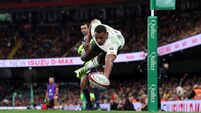Ó Sé may undergo hi-tech healing treatment
STATE-OF-THE-ART technology could be utilised by Kerry’s Darragh Ó Sé in his race to be passed fit for the All-Ireland SFC final against Mayo on September 26.
Kerry County Board are considering sending Ó Sé, who sustained a broken metatarsal bone in his right foot in Sunday’s semi-final victory over Derry, to a hyperbaric chamber in an effort to speed up the healing process.
“The situation is that we will are considering all options available to us at the moment and we will make a decision when we have all the information,” Kerry County Board chairman Seán Walsh said yesterday.
“But it will be a race against time for an injury of this nature,” he added.
Ó Sé has not had the foot put in cast, but the most optimistic estimate still puts the recovery period at four to six weeks.
He should be ready to resume very light training at that stage, but expecting him to play any meaningful part in the final against Mayo is completely unrealistic, say medical experts.
Apart from the bone itself, he will lose considerable fitness and co-ordination over the next month.
England soccer captain David Beckham undertook a similar approach after breaking a bone in his foot, prior to the World Cup finals in 2002.
Oxygen breathed inside such a chamber is no different from natural oxygen. However, the increased pressure allows oxygen to better enter tissues and aid the healing process.
The only such chamber available to sports people is at Éamonn Ó Muircheartaigh’s Maynooth physiotherapy and sports injury clinic.
“Blood carries oxygen attached to hemogloben. Room air contains 21% oxygen and at that the hemoglobin is fully saturated,” chartered physiotherapist Ó Muircheartaigh explained. “That is why a lot of athletes train at altitude. At altitude the air is thinner, more hemogloben is produced and thus the athlete performs better.
“Our chamber replicates the pressure equivalent of being in 33 feet of water. But in the chamber the patient is breathing 100% pure oxygen and speeds the healing process,” he said.
Breathing nearly pure oxygen in such a chamber obtains about five times more oxygen than breathed normally. Red blood cells fill instantly with oxygen, and the extra oxygen helps tissues deficient in oxygen. This action stimulates healing during and after a session. “By increasing oxygen, healing is going to be improved. We have used it for similar injuries for a number of sports and have enjoyed great success,” Ó Muircheartaigh said of the chamber. But will it have the Allstar fit enough to play some part in the repeat of the 1997 All-Ireland SFC decider?
“We would have to look at the X-ray of the injury to determine how serious the fracture is.
“Then we would be able to estimate the recovery time. But if Darragh were to come he would have to receive treatment on a daily basis.”
Ó Sé has broken the metatarsal bone alongside big toe, one of five such bones in each foot.
Located in the forefoot, they are the relatively long bones, that roughly cover the area just in front of the ankle down to the toes.
It is the part of the foot that footballers strike the ball with and as a result, this area is prone to injury.
Direct trauma due to a challenge can cause a fracture of the metatarsals. Alternatively, some fractures occur without contact if a person forcefully goes over on their ankle.
The signs and symptoms are extreme pain, loss of function and discolouration of the affected area.
As with all fractures, complete rest and immobilisation is required. Immobilisation can be achieved using several methods. A plaster of paris stops any movement and the orthopaedic consultant may order this for six weeks. However, there are problems such as muscle wasting, and a more modern approach is to use a pneumatic boot, which is removable and allows the patient to do some maintenance exercise.
The third method of immobilisation is surgical fixation, where a small screw is placed down the middle of the fractured metatarsal by the orthopaedic consultant. This is a sure way of getting the fracture to unite immediately, but the method has possible drawbacks including the risk of infection.
It normally takes one to two weeks for a callus to form, then about six weeks for the bone fragments to unite. Once united, there is a period of consolidation where the bone remodels itself to become stronger. This whole period can take between six to 12 weeks, depending on the constitution and diet of the individual, and the position and shape of the fracture.
The injury will usually be X-rayed at two weeks and then six weeks, to check the rate of healing.












